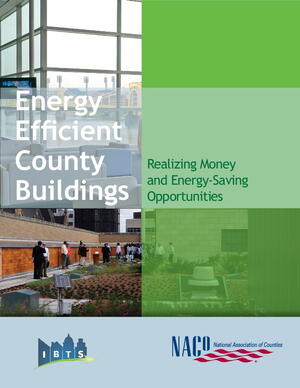
This report provides a summary of the data counties have provided to NACo through Portfolio Manager, EPA’s tool for monitoring utility costs and benchmarking facilities against their counterparts across the country. This Portfolio Manager analysis is a preview of our findings to come, and spans 21 states and totals more than 62 million square feet. The non-Portfolio Manager data will strengthen and deepen the database so that we may provide empirical conclusions and action strategies for producing significant cost savings Key findings:
- 33% of county facilities have an annual source energy use intensity (EUI), a measure that reflects energy performance relative to a building’s size, below the EPA’s national median
- 48% of county facilities have an annual source EUI at least twice the EPA’s national median, and
- The most popular building types in the database are offices (405 facilities), fire/police stations (101 facilities), courthouses (74 facilities), jails (45 facilities), and libraries (36 facilities)
The research team has found that many counties are poised to make 10% - 20% energy savings gains in their buildings by implementing low- to no-cost improvements and cost-neutral improvements that can be financed by a third party and paid over time through the resulting energy and operational cost savings. Some of these improvements include: upgrading mechanical and electrical systems; replacing lighting controls; adding energy management and information systems; upgrading heating, ventilation, and air conditioning systems (HVAC); replacing motors and pumps; and adding insulation.
Building the Database:
From June to October 2012, NACo’s research team contacted and interviewed county staff and elected
officials from nearly 400 counties to build the foundation for the County Building Database. The team
sought energy information from at least 90 counties of all sizes and climates to create a representative sample of counties nationwide. Through these individual interviews, NACo compiled data on:
- The number of buildings each county owns
- Building types in each county (jail, courthouse, office building, etc )
- Who the county’s utility providers are
- How the county receives and processes utility bills (paper vs electronic)
- If the county is tracking energy use and how (“homemade” spreadsheets, ENERGY STAR®’s Portfolio Manager Tool, a third party software system, etc ), and
- What kinds of energy upgrades the county has performed (lighting upgrades, equipment replacements, Energy Performance Contracts, etc )
Of the nearly 400 counties NACo interviewed, 94 provided monthly energy cost and use data for each of their county owned buildings. Several more counties provided data for some of the buildings in their portfolios NACo now has sufficient building information to benchmark common county building types, provide individual county assistance, and draw national conclusions about the state of county buildings.
